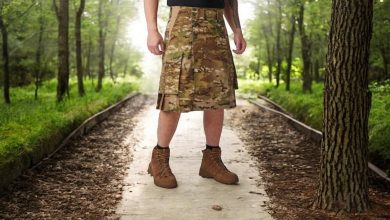Caring for Kilt Accessories: Tips for Longevity
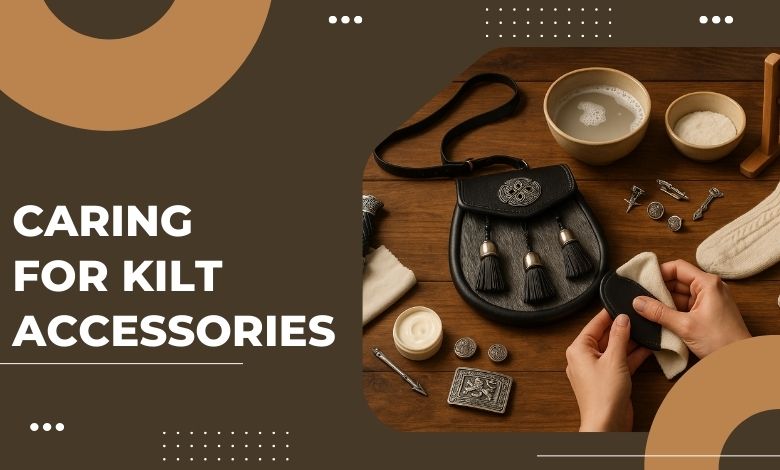
A kilt outfit is a complete set of accessories that Scots have been pairing with their traditional kilts for centuries. Every item has a distinct importance and plays a different role. Being important clarifies that every attachment also requires proper care to maintain its elegance and stay for a longer duration with you. This article explains all kilt accessories and tips to care for them. It will not let you reinvest in your attire quickly. Before diving into the tips for caring for kilt accessories, let us highlight the importance of their proper care.
Table of Contents
ToggleWhy Proper Care of Kilt Accessories Matters
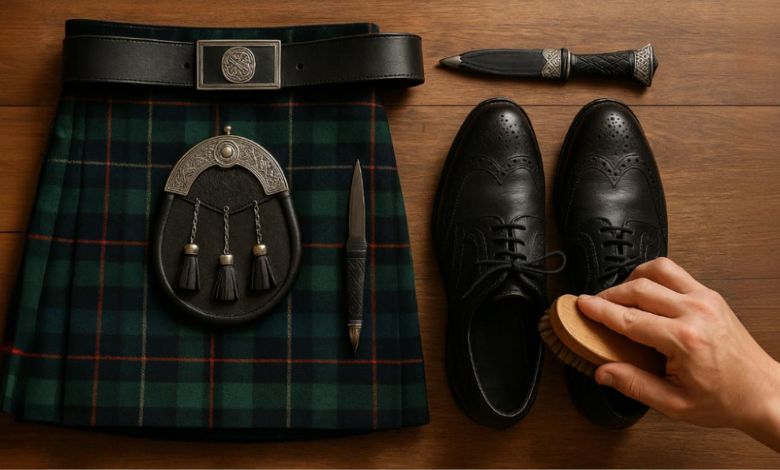
If cared for, any part of the kilt outfit will last longer. Moreover, this maintenance maintains its beauty and retains its cultural value. Kilts are made with different materials, and all of them have different care tips. Not only must they be cared for, but they must also be cleaned frequently, stored properly, and kept free of potential harm like mildew or moths. Doing so also lessens the chance of harm to the wool and other components of the kilt and its accessories.
Kilt garments and other accessories may be heavier investments, particularly if they are made with traditional workmanship. Thus, their sufficient maintenance is obligatory to preserve that investment. Other products like belts, brogues, and sporrans are examples of accompanying accessories that also need to be well-maintained to maintain their style and purpose.
How to Clean and Maintain Each Kilt Accessory
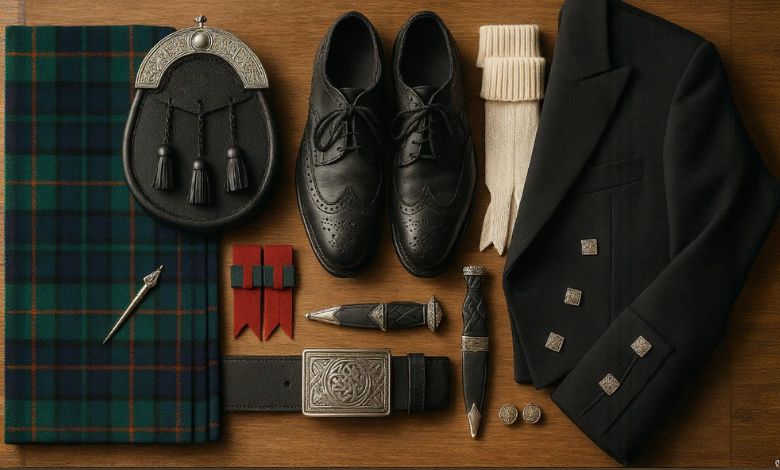
Traditional kilt outfits are suitable for formal events with ancient attachments. We discuss the components here that serve as an essential part of traditional outfits like sporrans, kilt pins, Ghillie brogues, etc. Let’s begin our list of accessories with kilts.
Kilt Itself
Kilt is the primary part of Scottish Highland Dress making the entire outfit popular worldwide. Traditional kilts are made with acrylic wool while the construction of modern ones involves multiple fabrics like leather, denim, cotton, etc. Every fabric has different requirements to care for. So, allow us to tell you about the popular ones:
Tartan Kilts: Traditional kilts or tartan kilts are made with wool fabric that is known for offering warmth, durability, and comfort. Regarding the caring tips, you are advised not to wash it often but to air dry after every wear. Prefer spot cleaning, if a stain bothers you. Still, necessary to wash, ensure to dip it into cold water filled with a mild detergent.
Leather Kilts: One of the bulkiest kilt variations and bold fashion statements for men, leather kilts also need proper care. Like the previous one, leather kilts are popular for being comfortable and strong. To enjoy its features, you also need to maintain it properly and Clean with a damp cloth and apply leather conditioner to preserve shine and prevent cracking. Conditioning also prevents cracking. Furthermore, there are several sprays available in markets today to make leather products entirely waterproof.
Utility Kilts: Known for their strong construction and flexibility, utility kilts are the perfect choice for work, hiking, and other activities. Unlike the previous ones, this variation is usually machine washable. Hang your utility kilt to dry and eliminate creases. Or you can use a press cloth and iron on a low level to preserve pleats.
Kilt Jackets
The next and one of the most important parts of Scottish dress adding an appeal to your personality is the kilt jacket. Most of these jackets are woolen whether they are Prince Charlie or Argyll Jackets. Being woolen means they are not washable, so you should brush them regularly. The rest of the steps include spot-cleaning stains, airing out the jacket after wear, and professional cleaning when necessary.
Sporran or A Kilt Bag
Sporran is a leather bag or pouch worn on the front side. The existence of sporrans in several variations highlights their importance and demand. Usually, they are made with original or faux leather. So, the caring techniques are the same as leather kilts, cleaning, conditioning, and spraying to make them waterproof.
Kilt Pin
A kilt pin is the smallest part of the outfit but its connection with the past highlights its significance. The pin is placed on the lowest corner of the outer apron of the kilt. It acts as both a fashionable and useful ornament. It is often composed of metals like pewter, silver, or brass that can get moisture. So, get rid of any moisture or fingerprints by carefully wiping it with a soft cloth once detached. If the tarnish develops, consider a mild and suitable polish for the material.
Belt & Buckle
Serving as a practical part of kilts for men, belts & buckles also admire the heritage, thanks to Celtic-designed buckles. Most of the belts are made with real leather and have sizable metal buckles. Both parts need proper care. So, periodically condition and clean belts with a moist cloth to maintain luster and elasticity. Moreover, make sure to keep them from water or sunshine. Keep the buckle dry and clean using a non-abrasive fabric to prevent rust. Most importantly, hang or lay them flat to maintain their form.
Flashes and Kilt Hose
Colorful garters called flashes are used with a kilt hose to hold them in place and provide a splash of colour that complements your plaid. Usually composed of cotton or wool and elastic, flashes should be hand-washed or spot-cleaned as needed. Consider not washing them in the machine so flashes may avoid stretching or damage. Likewise, kilt hoses are often made of wool or wool blend. You must prefer hand cleaning in cold water using a light detergent. When done with washing, lay them flat and air dry to maintain their stature.
Sgian Dubh (Knife)
No one can question the importance of Sgian-dubh or Scottish knives in an outfit. It’s practical and a decorative ornament that also requires care for longevity. So, you must consider cleaning it with warm water and mild dish soap after each use. Its wooden handle may get cracks while blades are prone to catch rust. Apply a food-safe mineral oil to the hardwood handle of the knife and store it in a dry place so the rust may not damage it. To maintain the blade’s sharpness, hone and sharpen it as required.
Kilt Brooches
Kilt brooches are a traditional part of attire so caring for them is essential too. You must clean the brooch often by removing dust and grime with a soft, dry cloth. The following step is storing them somewhere cool and dry. A jewelry box or wrapping it in a soft cloth to prevent scratching is the best idea. Its parts may get loose, so inspect and tighten them as needed. Last but not least, keep them away from strong chemicals and abrasive products so they may not impact their shine.
Dress Shirt Studs and Cufflinks
Ghillie shirts or kilt shirts typically require little maintenance because of their composition with cotton or a combination of cotton and polyester. The majority may be cleaned in a machine, ideally in cold water with similar colours. It can be better to spot-clean or hand-wash delicate shirts or ones with leather accents. Steer clear of strong cleaning agents that can harm the fibres.
General Tips for Longevity
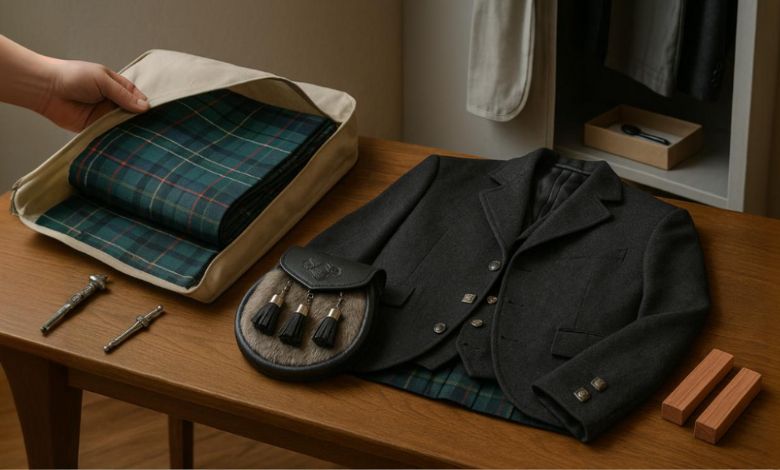
To make sure your whole Highland outfit continues to endure a few key practices are crucial. These standard procedures contribute to maintaining the material and cultural integrity of each kilt item in addition to preserving attractiveness.
Store Properly: Leaving kilt accessories exposed to the environment affects their outlooks. To avoid fading, warping, or mildew, keep items out of direct sunlight and place them in cool, dry places.
Avoid Over-Washing: After every wear, spot clean and let the kilt air out because most of its components do well with little washing.
Use Garment Bags: To keep dust and insects away, store leather or wool clothing in airy garment bags.
Regular Inspection: Periodically inspect accessories for tarnish, loose pieces, or wear; take care of problems early to prevent more damage.
Handle with Clean Hands: Always handle with clean, dry hands since hand oils and dirt can damage sensitive textiles and metals.
Rotate Wear: Rotating items prolongs their life and keeps them looking new, so try not to wear the same outfit over and over again without taking a break.
Weather Protection Tips
People assume water to be the most damaging element to traditional kilts and their attachments. Those particularly composed of metal, leather, and wool get massively impacted. So, you should stay out of the rain at all times. If you remain in rainy weather due to some reasons, let everything dry naturally rather than using direct heat. Similarly, applying waterproofing sprays designed for cloth and leather provides an extra layer of protection. When you are back, confirm that all parts are completely dry and finally clean them to avoid corrosion or rusting.
Reliable Store to Buy Long-Lasting Kilt Accessories!
The longevity of kilts and their accessories is usually impacted by purchasing products with compromised quality. So, you should avoid it and choose premium-quality products to let them stay for a longer duration with you. To do so, you need to shop for an outfit from a reliable brand like “Utility Kilt UK.” At our store, we offer a collection of all products, affordable prices, self-customization of kilts, excellent craftsmanship, and hassle-free return and exchange policies.
FAQs about Kilt About Accessories
How often should I clean my kilt accessories?
Though washing kilt components often is not a recommendation, you should clean them whenever you remove them. Do not clean them with rough clothes or chemicals. It will protect their aesthetics.
Can I wash my kilt hose in the washing machine?
No, it’s best to wash your kilt hose by hand to preserve the fabric and color. The fabric may not bear the cycles of the machine, similarly, shade damage is probable.
What type of leather conditioner should I use on my sporran?
The best leather conditioner for a sporran is one that protects and moisturises the leather without making it excessively supple or elastic.
Should I remove my kilt pin when I’m not wearing the kilt?
Indeed, it is usually advised to take off your kilt pin while you are not wearing a kilt. This will protect the kilt fabric from damage, particularly if you are careless when putting the pin in and taking it out.

